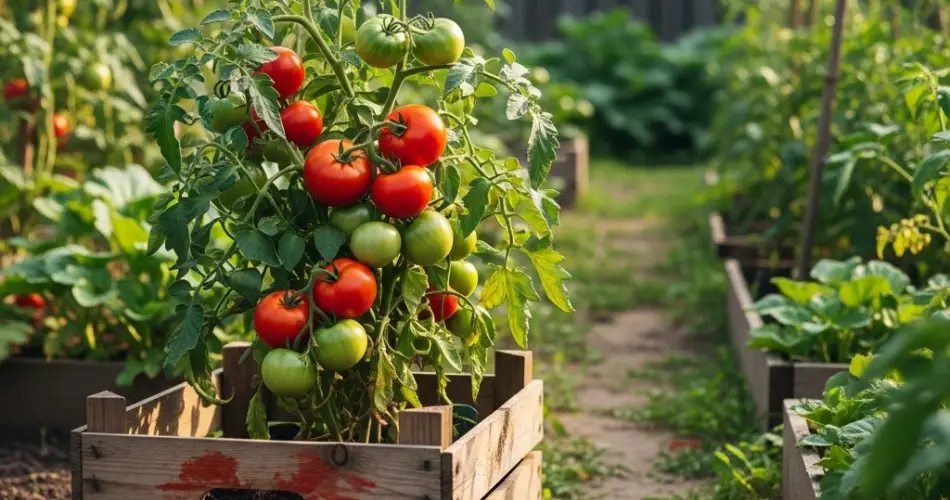Growing tomatoes in wooden boxes on a balcony is a rewarding and practical way to produce fresh, juicy fruits even when outdoor space is limited. This method offers several advantages: it’s space-saving, eco-friendly, and customizable to your available area. With a few basic materials and the right approach, you can enjoy a bountiful tomato harvest right outside your door.
Why Choose Wooden Boxes for Tomatoes?
Wooden boxes are ideal for container gardening. They provide ample root space, good drainage, and insulation against temperature fluctuations. Compared to plastic containers, wood is a more breathable material that helps prevent soil from overheating—something tomato plants appreciate.
You can repurpose crates, wooden drawers, or build your own boxes using untreated wood. As long as the box is deep and wide enough (at least 12–18 inches), it can support tomato plants effectively.
Materials Needed
To start your tomato balcony garden using wooden boxes, gather the following items:
-
Wooden box or crate (minimum 18 inches deep and wide)
-
Landscape fabric or plastic lining with drainage holes
-
Quality potting mix with compost or organic matter
-
Tomato seedlings (determinate or dwarf indeterminate varieties are ideal)
-
Organic fertilizer or compost tea
-
Mulch (straw, dried leaves, or coconut husk)
-
Tomato cage or stakes for support
-
Watering can or hose with a gentle spray setting
Choosing the Right Tomato Variety
When gardening on a balcony, space is a top consideration. Choose compact tomato varieties suited for container growing. Here are some good options:
-
Determinate types: These grow to a certain height and produce a single harvest, perfect for limited space.
-
Patio, Roma, or bush tomatoes: These varieties have smaller plants and still produce abundant fruit.
-
Cherry or grape tomatoes: These are great for snacking and highly productive in small containers.
Avoid large indeterminate varieties unless you have vertical space and strong trellising in place.
Preparing the Box
Line your wooden box with landscape fabric or perforated plastic to help retain soil while allowing water to drain. If the box has no drainage holes, drill several at the bottom to prevent waterlogging. Then, fill the box with a rich potting mix—ideally one part garden soil, one part compost, and one part coconut coir or perlite for aeration.
Leave about 1–2 inches of space at the top to prevent soil overflow during watering.
Planting the Tomatoes
Tomato seedlings should be planted deeper than they were in their nursery pots. Remove the lower leaves and bury about two-thirds of the stem. This allows the plant to grow additional roots from the buried stem, making it more stable and better at absorbing water and nutrients.
Water thoroughly after planting to help settle the soil.
Sunlight and Placement
Tomatoes need at least 6–8 hours of full sun daily. Place your wooden box in the sunniest part of your balcony—ideally facing south or west. If you’re in an area with intense midday sun, a bit of light shading during peak hours may help prevent leaf scorching.
Rotate the box occasionally to ensure even sun exposure on all sides of the plant.
Supporting Tomato Plants
As tomato plants grow, they need support to prevent stems from snapping under the weight of fruit. Install a tomato cage or tie the main stem to a sturdy stake using soft string or plant ties. This keeps the plant upright and helps air circulate, reducing the risk of fungal diseases.
Watering and Feeding
Consistent watering is crucial. Keep the soil evenly moist but not soggy. In hot weather, daily watering may be needed, especially if your box is exposed to direct sun. Water at the base of the plant, avoiding wetting the leaves to reduce disease risk.
Feed your plants every 2–3 weeks with compost tea, seaweed solution, or a balanced organic fertilizer. Once flowers appear, switch to a fertilizer higher in potassium to support fruit development.
Mulching
Apply a 1–2 inch layer of mulch around the base of the plant. This conserves moisture, keeps roots cool, and prevents weed growth. Organic mulch materials like straw or coconut husk work well in containers.
Pruning and Maintenance
For determinate varieties, minimal pruning is needed. For indeterminate types, remove the suckers (small shoots between the main stem and branches) to focus the plant’s energy on producing fruit. Regularly check for pests like aphids or whiteflies and treat them with neem oil or a mild soap solution if needed.
Remove yellowing or diseased leaves promptly to keep the plant healthy.
Harvesting Your Tomatoes
Tomatoes are ready to harvest when they have reached full color and are slightly soft to the touch. Gently twist the fruit off the vine or cut it with scissors to avoid damaging the plant. Regular harvesting encourages more fruit production.
End-of-Season Care
After the final harvest, remove the plant and discard any diseased foliage. Compost the remaining healthy plant matter. The soil in your wooden box can be refreshed with new compost and used for another planting cycle.
Final Thoughts
Growing tomatoes in wooden boxes on your balcony is a simple yet satisfying project. It transforms a small urban space into a productive garden spot. With sunlight, good soil, and attentive care, you can enjoy delicious homegrown tomatoes all season long—straight from your balcony to your plate.



